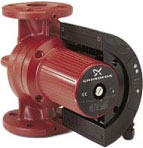Environmental Screening and Evaluation of Energy-using Products (EuP) Final Report
12 Electric motors 1-150 kW, water pumps (commercial buildings, drinking water, food, agriculture), circulators in buildings, ventilation fans (non-residential) (Lot 11)
- 12.1 Background
- 12.2 Environmental screening based on the Ecoinvent database
- 12.3 Ecolabel requirements
- 12.4 Technology and market trends
- 12.5 Conclusion
12.1 Background
This product group covers the following 4 product categories:
- Electric motors 1-150kW
- Water pumps (in commercial buildings, drinking water pumping, food industry, agriculture)
- Circulators in buildings
- Ventilation fans (non-residential buildings)
12.2 Environmental screening based on the Ecoinvent database
As there are no data in the Ecoinvent database for this theme, an environmental screening has not been performed for this product group.
12.3 Ecolabel requirements
It has not been possible to identify relevant Ecolabel criteria for this product group.
In March 2005, four European pump manufacturers announced an agreement on what is currently a voluntary energy-labelling scheme to Europe. The four companies who signed up to the scheme were: Grundfos Pumps (who initiated the scheme); Wilo; Smedegaard and Circulating Pumps who between them cover approximately 80% of the European market for circulator pumps.
The result is based on the pumps Energy Efficiency Index (EEI). The classification relates to independent circulator pumps with integrated pumps and motors.
12.4 Technology and market trends
The general technology trends for motors, pumps, fans and ventilation equipment is described in the EuP Preparatory report. Since pump technology is a Danish stronghold, the authors have added some comments to the technological development in this area.
Pump technology accounts for 20% of the world’s annual electricity consumption, so energy- efficient products offer great scope for savings. Pumps are the single largest user of electricity in industrial and commercial applications in the UK consuming 47.24 TWh of electricity, which in turn represents some 32% of all electric motor consumption in industry and commerce.
The UK government's Department of the Environment, Food and Rural Affairs (DEFRA) have set specific targets for the savings they want to see from pumps: 1,033 GWhr by 2010 (2%) and 4,265 GWhr by 2020 (9%).
Circulator pumps are used for heating, ventilation and air-conditioning in domestic houses, office buildings, hotels, etc. In the industry the pumps are used in processes as well as in the area of plant maintenance and in the water-supply and waste-water segment. With an annual production of more than 10 million pump units, the Danish company Grundfos is one of the world's leading pump manufacturers. Circulator pumps, submersible pumps, and centrifugal pumps are the three major product groups. Today, Grundfos is the world's largest manufacturer of circulator pumps, covering approximately 50 per cent of the world market for these pumps.

Intelligent pumps fitted with electronics allow for considerable reductions in energy consumption of up to 50%. The technology behind these advances emanates from the development of permanent magnet motors, as these dramatically increase motor efficiency. They operate by drawing on the energy to drive the motor from magnets in the rotor, not just the mains. This allows these pumps to operate at optimal efficiency at any output. The integrated sensor monitors conditions in the system and a frequency converter then regulates the motor speed accordingly, so only the minimum power is used. The electronic circuitry used to control the pump typically consist of nano-coated MEMS (micro electro-mechanical systems) silicone pressure sensors, control circuitry on silicon substrates.
Put into place to support the Energy Labelling system the Energy Project show significant results right across Europe, with estimates that the amount of energy saved as a result of the installation of increased efficiency circulators in the 120 million private European residences, commercial buildings and light industry combined to make a saving of an astonishing 400 million kWh in the first year. This saving equates to the annual energy consumption of 88,000 homes.
Combined with a design specifically aimed at optimising energy efficiency, this has earned the Grundfos MAGNA series a class 'A' rating in the European energy labelling scheme. Many other manufacturers have since joined the variable speed portfolio and all applications that are suitable candidates for variable speed pump technology now benefit from having a wide range of options available to them. According to Grundfos, all Grundfos pumps installed in 2001 alone resulted in a total power saving equivalent to the annual consumption of 283,000 households in the western world. This equates a drop in CO2 emissions of approximately 796,000 tons.
12.5 Conclusion
12.5.1 Environmental impact in a system and life-cycle perspective
This product group is a horizontal group that should be seen in the system approach that the authors find is a more reasonable approach to assess the environmental impact.
In view of the paradigm of “Central production – local control”, the need for intelligent and controllable motors is evident. They perform the necessary building blocks for executing the local control. The trend in intelligent pumps thus fully illustrates the need and the possibilities that exist for energy savings, when the control of energy consumption is done locally and in the context, in which the consumption takes place.
Version 1.0 December 2009, © Danish Environmental Protection Agency